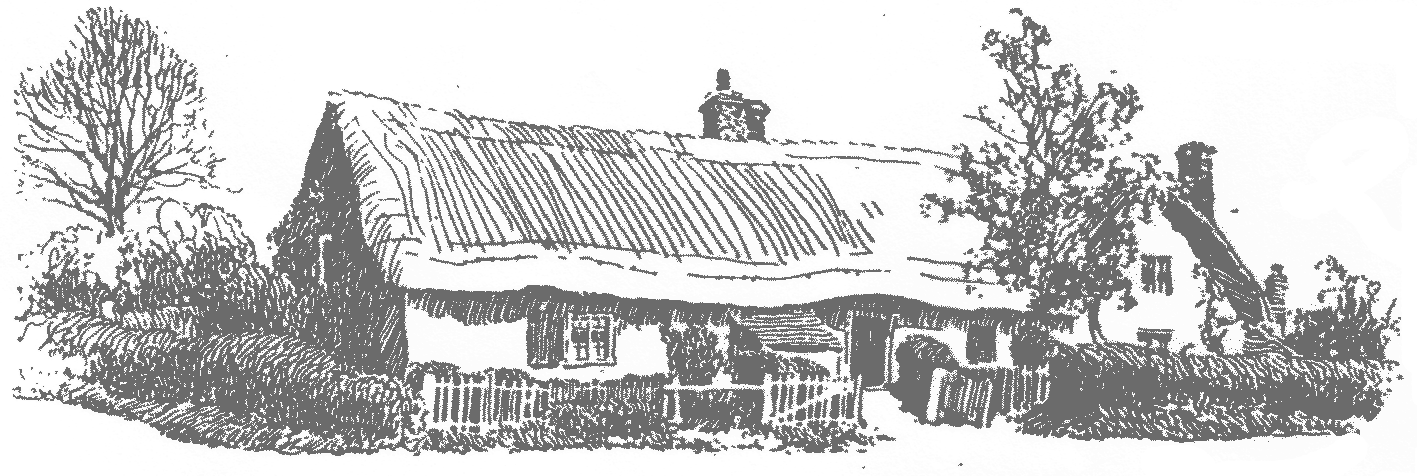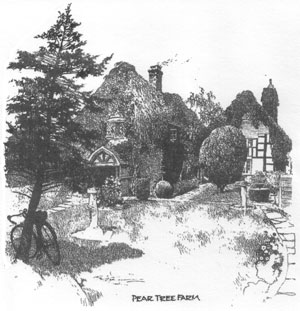ENGLAND'S BEST KNOWN, UNKNOWN ARTIST.
At the end of the 18th century Billingshurst was just another, unremarkable, Sussex village, situated some six miles from the town of Horsham. To the north of the town most of the land had been owned for generations by the Duke of Norfolk. In the middle of a sea of fields stood an Elizabethan farmhouse that had stood empty for years. Early in 1898 it was let to a young man named Frank Patterson and his wife Emily for an annual rent of nine-pence (3½p). A local builder was employed to make it habitable and by the end that same year they took up residence in the house that was to remain their home for the next 54 years. The house had no name, so with deference to the only recognisable tree in the jungle that was to become their garden, they named it Pear Tree Farm.
In appearance Patterson was indistinguishable from the
local farmers dressed in tweeds, boots and gaiters, with the same hat
on his head both summer and winter it could be assumed that he was also
a farmer; but appearances can be deceptive. His land was rented out and
he kept no cattle,  so
where did his income come from? The source of his income was stranger
than anyone could have imagined. This man, so rough in appearance, with
hands like hams, was an artist, producing the most delicate wistfull pen
and ink drawings to a standard that has seldom been equalled, but never
bettered.
so
where did his income come from? The source of his income was stranger
than anyone could have imagined. This man, so rough in appearance, with
hands like hams, was an artist, producing the most delicate wistfull pen
and ink drawings to a standard that has seldom been equalled, but never
bettered.
Frank Patterson was born in Portsmouth in 1871 into a family that had followed the sea for generations and was expected to continue the tradition. His interests however were more artistic than seafaring so he enrolled at the Portsmouth School of Art. When his studies were complete he could find little employment locally so he packed his bags and walked to London to seek fame and fortune; only to discover that talent has little to do with success and producing illustrations for books and maqazines was the only way he could make a living. Paradoxically this is where his true genius lay, for fine pen and ink drawing was to make him famous and admired by generations of cyclists and artists. His early work for a commercial studio tightened his technique and created a style that was unmistakably by his hand. Most of his drawing was with a Gillott 303 pen with a goose quill for "slapping in the pork", to use his own expression.
His connection with the magazine Cycling and Temple Press
began in 1893, the year they accepted his first drawing. He also did work
for other magazines owned by the company. When a young man Patterson embraced
the fashionable pastime of cycling: travelling like some latter day Cobbett
he used the countryside of Sussex and Surrey as a source for his drawings.
An injury to his leg when he was 38 restricted his cycling activity, so he resorted to long distance walking,
sometimes covering up to fifty miles a day in his wanderings. He also
worked from photographs and postcards sent by friends from all over the
country. In addition to cycling and country subjects he produced pictures
of the Boer War for the London Illustrated News, and illustrations
for The Book of the Home and The House. For the magazine
Cycling and The Gazette, the Cyclists’ Touring
Club magazine, his output was phenomenal, producing some 26,000 drawings.
During the 59 years that he worked for the two publications he boasted
that he never missed a deadline, certainly he built a reputation for reliability
that is rare among artists.
38 restricted his cycling activity, so he resorted to long distance walking,
sometimes covering up to fifty miles a day in his wanderings. He also
worked from photographs and postcards sent by friends from all over the
country. In addition to cycling and country subjects he produced pictures
of the Boer War for the London Illustrated News, and illustrations
for The Book of the Home and The House. For the magazine
Cycling and The Gazette, the Cyclists’ Touring
Club magazine, his output was phenomenal, producing some 26,000 drawings.
During the 59 years that he worked for the two publications he boasted
that he never missed a deadline, certainly he built a reputation for reliability
that is rare among artists.
His critics say that his work is mannered, slick and formal; to many it is considered so, but to others his talent shows a joyful celebration of our beautiful countryside. Nostalgia is a popular sentiment these days, so perhaps he will best be remembered for recalling the golden days of yesteryear.
He continued working up to the last days of his life; even at eighty he was capable of the most delicate and accurate draughtsmanship and despite the years his hand had lost none of its' skill. In 1950 his health began to deteriorate and on the 17th July 1952 he died. At his own request his ashes were scattered at his beloved Pear Tree Farm.
© Gerry Moore 2005.